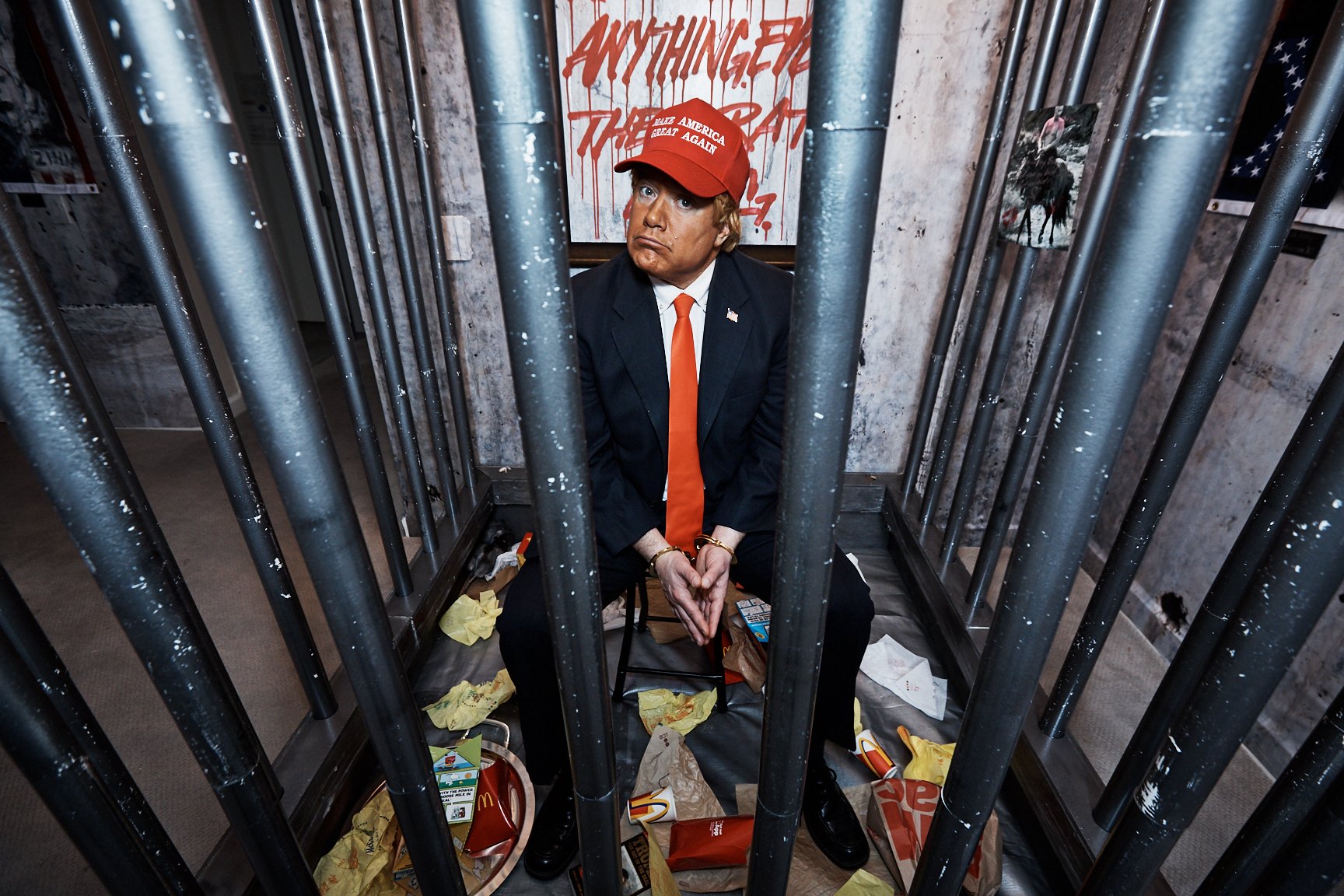
Is Donald Trump a prisoner of his own gilded cage? One anarchist art collective seems to think so.
Operating with the utmost secrecy, the anonymous group INDECLINE infiltrated Trump International Hotel and Tower last week and turned a $1,000-a-night suite into a radical art installation titled “The People’s Prison,” locking a Donald Trump impersonator in a cage full of live rats. The room was transformed into a jail with bleak cement walls featuring the work of 13 artists, each of whom painted a portrait of an American activist or revolutionary on an American flag.
“We were inspired by the Russia investigation. The walls are kind of closing in for Trump,” an INDECLINE member told artnet News of the project, the culmination of six month’s planning. “We wanted to imprison him within his castle.”
“Throughout American history, there’s been a very vibrant political resistance culture,” he added, pointing to the portraits of Hunter S. Thompson, Betty Friedan, Muhammad Ali, Noam Chomsky, Angela Davis, and others. “Trump is the antithesis of what actually makes America great. So we wanted to surround him with these people. This is the America that we’re proud of, this is part of our history that we are inspired by, these are the people we look to as an example in these turbulent times.”
INDECLINE, “The People’s Prison” (installation view at Trump International Hotel and Tower in New York), 2018. Photo courtesy of Jason Goodrich.
The works are created in a wide range of styles by a variety of artists: Tattoo artist Jesse Hazelip painted Cornell West, while street artist LMNOPi selected Native American activist Lyla June Johnson. Stencil artist Anthony Aspero chose NSA whistleblower Edward Snowden.
“We’ve been pushing back on Trump since long before his presidency,” artist Ann Lewis told artnet News. “We all realize this isn’t a sprint—it’s a marathon. It’s a very draining process to always be responding to all this chaos.”
Lewis’s flag portrays Erica Garner, who died of heart attack at age 27 last year. Garner became an outspoken activist against police brutality after her father, Eric Garner, was killed in police custody in 2014. “Erica Garner stood for everything that Donald Trump is not,” said Lewis. “She died fighting for the rights of those whose voices are silenced by the state. She is yet another martyr of the movement for justice and equality in this country.”
INDECLINE, “The People’s Prison” (installation view at Trump International Hotel and Tower in New York), 2018. Photo courtesy of Jason Goodrich.
Only a small group of journalists were invited to experience the pop-up exhibition, with INDECLINE preferring to communicate the details over encrypted channels to avoid detection by the authorities. The team scouted the room ahead of time to plan for the installation, which took place over the course of 24 hours. Hotel bellboys unwittingly carried in suitcases filled with the contraband artworks, while members of the collective dressed up for the occasion, donning suits and instructing the concierge that they would be having a number of business meetings during their stay.
Entering the room was a surreal experience, leaving behind the warm golden glow of Trump Tower for what seemed like a scene out of some sort of apocalyptic future. The room was unrecognizable save for a crystal chandelier hanging over Trump’s head; it had been cleared of all furniture, which was moved to the adjoining room. (The collective restored the room to its original appearance before checking out, using reference photos to make sure nothing was out of place.)
Before the installation of INDECLINE’s “The People’s Prison” at Trump International Hotel and Tower in New York. Photo courtesy of Jason Goodrich.
Trump, shackled by golden handcuffs, sat behind bars, his cell filled with discarded McDonald’s food wrappers and live rats, captured humanely, according to the collective, from the streets of Brooklyn. Impersonator Bob DiBuono kept up a steady patter of color commentary, promising to escape and lock up Hillary Clinton in his place, while an eerie soundtrack, featuring selections of speeches from the artworks’ subjects set to unsettling music, played in in the background.
A group of activists, graffiti artists, filmmakers, and photographers, INDECLINE was founded in 2001. The collective made headlines ahead of the 2016 presidential election with The Emperor Has No Balls, erecting statues of a grotesque naked, poorly endowed Trump in New York, San Francisco, Los Angeles, Cleveland, and Seattle.
INDECLINE, “The People’s Prison” (installation view at Trump International Hotel and Tower in New York), 2018. Photo courtesy of Jason Goodrich.
To create the statues, INDECLINE commissioned Ginger, a Las Vegas-based artist who creates work for haunted houses. Julien’s Auctions is currently advertising the sale of “the last statue remaining not vandalized or destroyed,” to take place May 2 at New Jersey’s Mana Contemporary. Though the statue is being billed as one of the original works from the guerrilla art installation, Mana’s Moishe Mana commissioned two additional copies of the statue from INDECLINE after the fact.
“We sent Julien’s Auctions an invoice and said ‘You know they bought one, right? That’s not one of the original five,'” a representative of INDECLINE told artnet News. “They kind of just told us to fuck off.”
Bystanders take photos of INDECLINE’s illegally erected statue of a naked GOP presidential candidate Donald Trump, which appeared in San Francisco on August 18, 2016. Courtesy of Justin Sullivan/Getty Images.
Despite the kerfuffle, the collective is looking to the future, not the past. They’ll be restaging “The People’s Prison” in a public art exhibition, opening April 19 and on view for a month at Gallery 30 South in Pasadena, California. All of the flag paintings will be on sale ($1,300–7,000), with the proceeds benefitting various charities.
Watch a video of the guerrilla art project below.